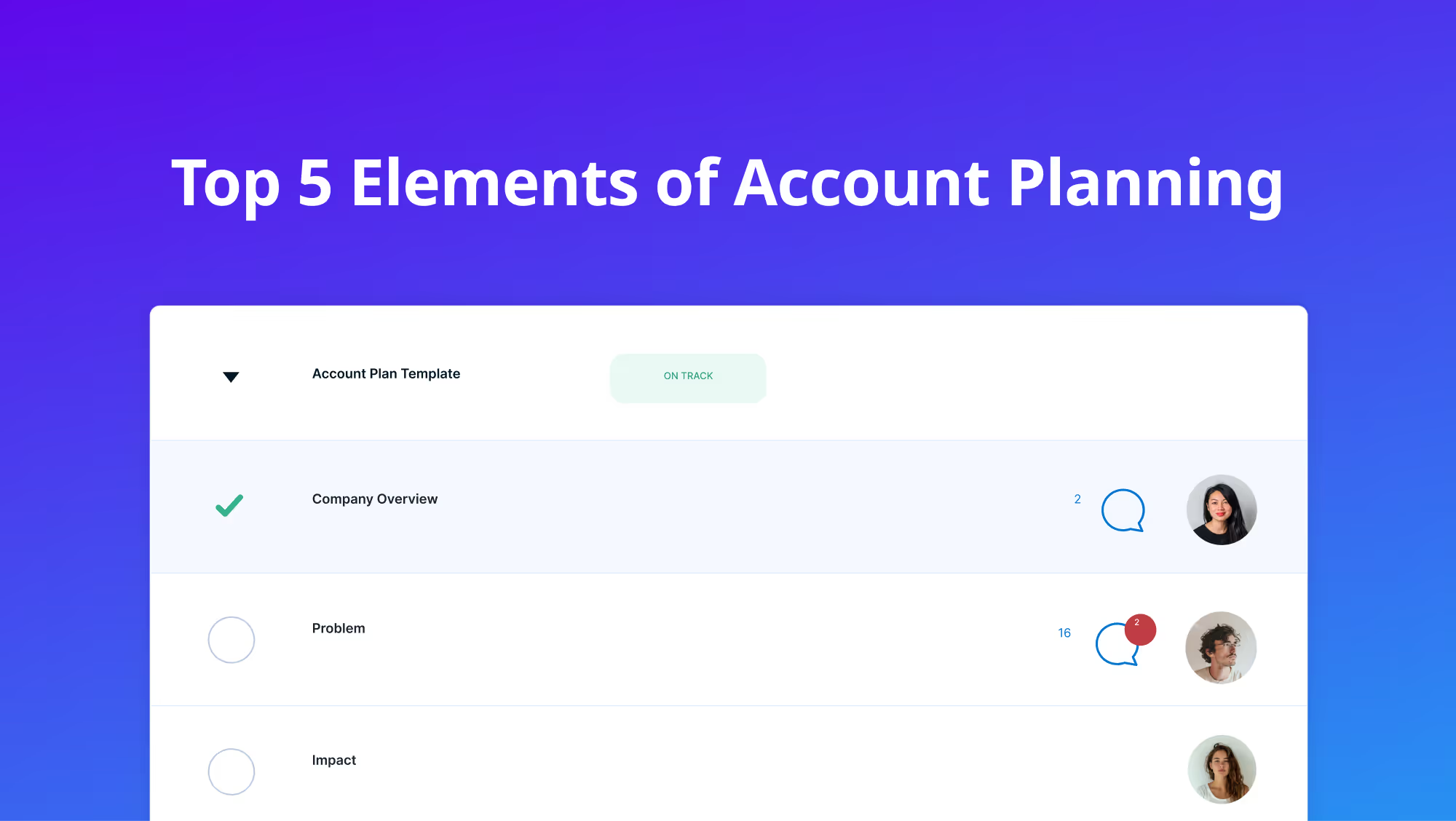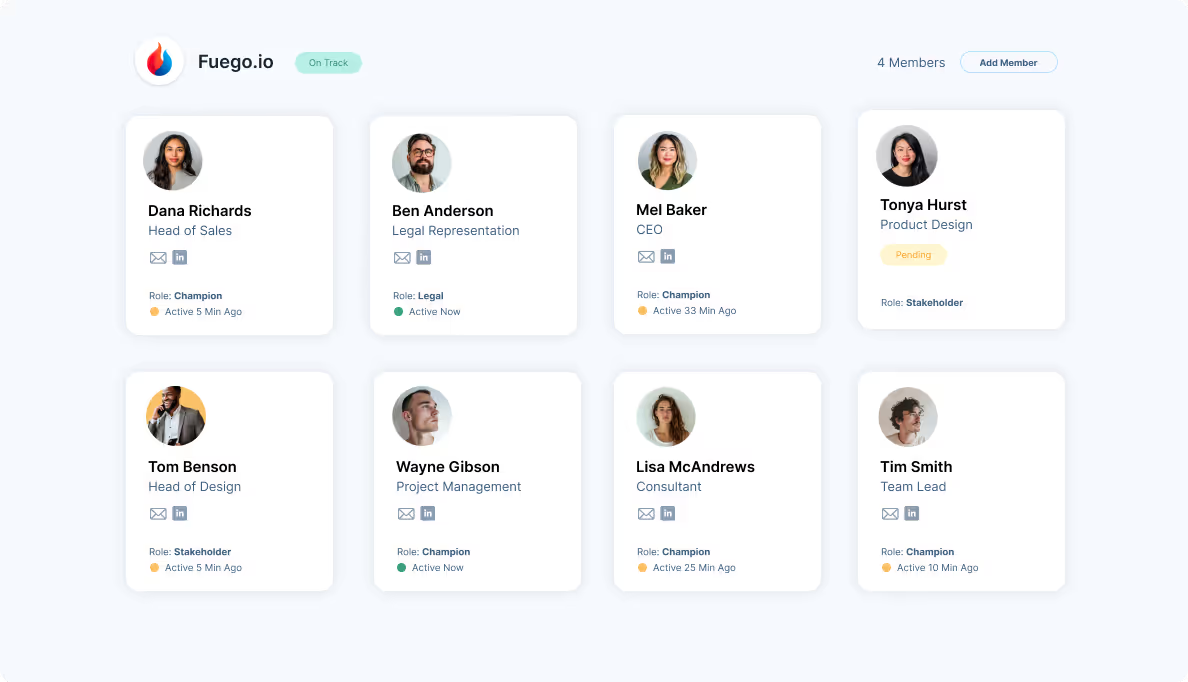Learn how to create account plans that cover everything from the problem, impact, solution, people, and plan.

In today’s highly competitive B2B sales landscape, account planning isn’t just advantageous — it’s essential. To close new business opportunities or renew existing accounts, your organization needs to stand out and solve real problems.
This article explores what account mapping is, why it’s important, mistakes to avoid, and the essentials needed to create a solid plan.
Let’s get started!
In B2B sales, account planning is the process of mapping important details about your potential clients and existing customers. You gather information about their priorities and challenges to develop targeted sales strategies in order to close new deals and retain or upsell current customers.
Interactions are customized to the specific needs of each decision maker. As a result, reps build trust and rapport, allowing them to grow and nurture relationships all while shortening the deal cycle.
Account planning is often referred to by a variety of other terms. While these terms are often used interchangeably, each one can carry its own meaning:
Account planning is important in B2B sales strategies because it helps reduce acquisition costs, build strong client relationships, enhance cross-selling and up-selling opportunities, and improve customer retention.
By identifying key accounts and focusing efforts where they are most likely to yield results, organizations can optimize their sales force’s productivity, reducing time spent on leads less likely to convert.
Not all account plans are created equal. Lack of research, personalization, and irregular updates can cost you — big time. In this section, we’ll outline several account mapping mistakes to avoid.
As the saying goes, “the devil is in the details.” This is especially true when it comes to account planning. If you are overlooking important information, like the company’s specific challenges, goals, and operating model, then you won’t have a solid understanding of how your solution can help.
This puts you at an obvious disadvantage because it means you’ll only have a superficial understanding of the organization, and it will be difficult to position your solution as a vital ingredient to the organization’s success.
Part of putting together a solid B2B account plan means you know who the key decision makers are. Without a complete picture of the people and processes that influence decision making, you’ll waste time and resources as you attempt to find the right contacts to close the deal.
In life, the one constant is change. The same is true for your accounts. Regularly review and update your account maps to ensure the information is up to date and accurate. Consider any changes in personnel, business goals, or challenges.
You can gather this information by checking in regularly with the key stakeholders or your account champion.
Part of winning trust and building rapport means you have a thorough understanding of your product’s strengths and weaknesses. But you can’t just benchmark against yourself — you need to be well versed in the competitive landscape.
Be an expert on all things competitor related. Know who your competitors are, where they excel, and what their vulnerabilities are.
When it comes to formatting your account plan, you have lots of options. You can use slides, word documents, PDFs, Prezi, spreadsheets, Accord, and so forth. It’s not the output that matters, it’s the input and thought process (remember, research is key!).
Your account plan should always include five key elements: the problem, impact, solution, people, and plan. In this section, we’ll explore each of these elements in detail. Let’s dive in!
Before outlining the five key elements, start by gaining an in-depth understanding of how the organization is structured and functions. Some key information you’ll want to collect includes:
Take your time and be thorough when collecting this information. You want to make sure your insights are accurate and up to date so you can craft an effective account plan.
Once you have your company overview in place, it’s time to do some detective work and identify the prospect’s primary challenge(s). Don’t make assumptions based on the information you gathered from the overview. Ask questions and lead with genuine curiosity.
Open-ended questions, in particular, work well because they encourage more detailed responses. Listen carefully to the answers, and use the information provided to ask follow-up questions. This will help you isolate the specific pain points your prospect is facing so you can illustrate how your solution helps solve their problems.
Here are some questions that will help you identify the problem:
Once you have enough information to pinpoint the core issue, validate your understanding with a confirming question. Here’s an example: “Based on our conversation, it sounds like the biggest problem you’re currently facing is XYZ. Does that accurately reflect your situation?” This approach ensures you aren’t leading with assumptions.
This element of the account plan helps you determine why now is the best time for the prospect to make a change. To assess the prospect’s urgency, consider the following:
Having established the problem and why the prospect needs to make a change, the next step is to map out why your solution is the optimal choice. This stage involves evaluating the competitive landscape, and outlining your competitors strengths and weaknesses. Pay special attention to how your solutions outperforms competitors in the areas relevant to your prospects situation.
Here are some areas to outline:
If you’re focusing on an existing client, then your approach will vary. You will consider:
The people element is all about understanding who is involved in the decision-making process and the dynamics of your relationship with them. Essentially, you’ll create an org chart listing each person and their role so you can customize your outreach in a way that makes sense and resonates.

To map out the people, identify:
The final step is strategic account planning. This happens when you consolidate your insights and create an action plan for winning the deal or renewing or upselling an existing client. It outlines the steps, timeline, and responsibilities of each team member to drive the account forward.
In this part of sales planning, you will iron out:
In the complex and ever-changing world of B2B sales, account planning helps reduce deal uncertainty. By creating a key account plan for each prospect and client, reps can focus on deals that are likely to close while building trust and rapport.
For managers, the account mapping process enables better, more accurate forecasting. It provides a data-driven view of potential sales outcomes so managers can help their teams determine where to focus and when.
To get started with account planning, download this plug-and-play template.